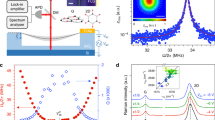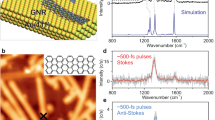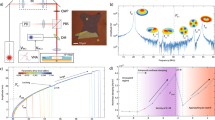Abstract
Energy decay plays a central role in a wide range of phenomena1,2,3, such as optical emission, nuclear fission, and dissipation in quantum systems. Energy decay is usually described as a system leaking energy irreversibly into an environmental bath. Here, we report on energy decay measurements in nanomechanical systems based on multilayer graphene that cannot be explained by the paradigm of a system directly coupled to a bath. As the energy of a vibrational mode freely decays, the rate of energy decay changes abruptly to a lower value. This finding can be explained by a model where the measured mode hybridizes with other modes of the resonator at high energy. Below a threshold energy, modes are decoupled, resulting in comparatively low decay rates and giant quality factors exceeding 1 million. Our work opens up new possibilities to manipulate vibrational states4,5,6,7, engineer hybrid states with mechanical modes at completely different frequencies, and to study the collective motion of this highly tunable system.
This is a preview of subscription content, access via your institution
Access options
Access Nature and 54 other Nature Portfolio journals
Get Nature+, our best-value online-access subscription
$29.99 / 30 days
cancel any time
Subscribe to this journal
Receive 12 print issues and online access
$259.00 per year
only $21.58 per issue
Buy this article
- Purchase on Springer Link
- Instant access to full article PDF
Prices may be subject to local taxes which are calculated during checkout




Similar content being viewed by others
References
Rayleigh, J. W. Some general theorems relating to vibrations. Proc. London Math. Soc. s1–4, 357–368 (1871).
Onsager, L. Reciprocal relations in irreversible processes. I. Phys. Rev. 37, 405–426 (1931).
Caldeira, A. O. & Leggett, A. J. Path integral approach to quantum Brownian motion. Physica 121A, 587–616 (1983).
Faust, T., Rieger, J., Seitner, M. J., Kotthaus, J. P. & Weig, E. M. Coherent control of a classical nanomechanical two-level system. Nat. Phys. 9, 485–488 (2013).
Okamoto, H. et al. Coherent phonon manipulation in coupled mechanical resonators. Nat. Phys. 9, 480–484 (2013).
De Alba, R. et al. Tunable phonon–cavity coupling in graphene membranes. Nat. Nanotech. 11, 741–746 (2016).
Mathew, J. P., Patel, R. N., Borah, A., Vijay, R. & Deshmukh, M. M. Dynamical strong coupling and parametric amplification of mechanical modes of graphene drums. Nat. Nanotech. 11, 747–751 (2016).
Gao, J., Zmuidzinas, J., Mazin, B. A., LeDuc, H. G. & Day, P. K. Noise properties of superconducting coplanar waveguide microwave resonators. Appl. Phys. Lett. 90, 102507 (2007).
Eichler, A. et al. Nonlinear damping in mechanical resonators made from carbon nanotubes and graphene. Nat. Nanotech. 6, 339–342 (2011).
Zaitsev, S., Shtempluck, O., Buks, E. & Gottlieb, O. Nonlinear damping in a micromechanical oscillator. Nonlinear Dynamics 67, 859–883 (2012).
Imboden, M., Williams, O. A. & Mohanty, P. Observation of nonlinear dissipation in piezoresistive diamond nanomechanical resonators by heterodyne down-mixing. Nano Lett. 13, 4014–4019 (2013).
Mahboob, I. et al. Dispersive and dissipative coupling in a micromechanical resonator embedded with a nanomechanical resonator. Nano Lett. 15, 2312–2317 (2015).
Polunin, P. M., Yang, Y., Dykman, M. I., Kenny, T. W. & Shaw, S. W. Characterization of MEMS resonator nonlinearities using the ringdown response. J. Microelectromech. Sys. 25, 297–303 (2016).
Dykman, M. I. & Krivoglaz, M. A. Theory of nonlinear oscillator interacting with a medium. Sov. Phys. Rev. 5, 265–442 (1984).
Wilson-Rae, I. Intrinsic dissipation in nanomechanical resonators due to phonon tunneling. Phys. Rev. B 77, 245418 (2008).
Rieger, J., Isacsson, A., Seitner, M. J., Kotthaus, J. P. & Weig, E. M. Energy losses of nanomechanical resonators induced by atomic force microscopy-controlled mechanical impedance mismatching. Nat. Commun. 5, 3345 (2014).
Tao, Y., Boss, J. M., Moores, B. A. & Degen, C. L. Single-crystal diamond nanomechanical resonators with quality factors exceeding one million. Nat. Commun. 5, 3638 (2014).
Midtvedt, D., Croy, A., Isacsson, A., Qi, Z. & Park, H. Fermi-Pasta-Ulam physics with nanomechanical graphene resonators: intrinsic relaxation and thermalization from flexural mode coupling. Phys. Rev. Lett. 112, 145503 (2014).
Gil-Santos, E. et al. Nanomechanical mass sensing and stiffness spectrometry based on two-dimensional vibrations of resonant nanowires. Nat. Nanotech. 5, 641–645 (2010).
Hanay, M. S. et al. Single-protein nanomechanical mass spectrometry in real time. Nat. Nanotech. 7, 602–608 (2012).
Chaste, J. et al. A nanomechanical mass sensor with yoctogram resolution. Nat. Nanotech. 7, 301–304 (2012).
Moser, J., Eichler, A., Güttinger, J., Dykman, M. I. & Bachtold, A. Nanotube mechanical resonators with quality factors of up to 5 million. Nat. Nanotech. 9, 1007–1011 (2014).
Antonio, D., Zanette, D. H. & Lopez, D. Frequency stabilization in nonlinear micromechanical oscillators. Nat. Commun. 3, 806 (2012).
Eichler, A., del Álamo Ruiz, M., Plaza, J. A. & Bachtold, A. Strong coupling between mechanical modes in a nanotube resonator. Phys. Rev. Lett. 109, 025503 (2012).
Chen, C. et al. Performance of monolayer graphene nanomechanical resonators with electrical readout. Nat. Nanotech. 4, 861–867 (2009).
Singh, V. et al. Probing thermal expansion of graphene and modal dispersion at low-temperature using graphene nanoelectromechanical systems resonators. Nanotechnology 21, 165204 (2010).
Barton, R. A. et al. Photothermal self-oscillation and laser cooling of graphene optomechanical systems. Nano Lett. 12, 4681–4686 (2012).
Miao, T., Yeom, S., Wang, P., Standley, B. & Bockrath, M. Graphene nanoelectromechanical systems as stochastic-frequency oscillators. Nano Lett. 14, 2982–2987 (2014).
Weber, P., Güttinger, J., Tsioutsios, I., Chang, D. E. & Bachtold, A. Coupling graphene mechanical resonators to superconducting microwave cavities. Nano Lett. 14, 2854–2860 (2014).
Song, X., Oksanen, M., Li, J., Hakonen, P. J. & Sillanpää, M. A. Graphene optomechanics realized at microwave frequencies. Phys. Rev. Lett. 113, 027404 (2014).
Singh, V. et al. Optomechanical coupling between a graphene mechanical resonator and a superconducting microwave cavity. Nat. Nanotech. 9, 820–824 (2014).
Weber, P., Güttinger, J., Noury, A., Vergara-Cruz, J. & Bachtold, A. Force sensitivity of multilayer graphene optomechanical devices. Nat. Commun. 7, 12496 (2016).
Eichler, C., Salathe, Y., Mlynek, J., Schmidt, S. & Wallraff, A. Quantum-limited amplification and entanglement in coupled nonlinear resonators. Phys. Rev. Lett. 113, 110502 (2014).
Lifshitz, R. & Cross, M. Nonlinear dynamics of nanomechanical and micromechanical resonators. Rev. Nonlinear Dyn. Complex. 1, 1–48 (2008).
Seoánez, C., Guinea, F. & Castro Neto, A. H. Dissipation in graphene and nanotube resonators. Phys. Rev. B 76, 125427 (2007).
Eriksson, A. M., Midtvedt, D., Croy, A. & Isacsson, A. Frequency tuning, nonlinearities and mode coupling in circular mechanical graphene resonators. Nanotechnology 24, 395702 (2013).
Benyamini, A., Hamo, A., Kusminskiy, S. V., von Oppen, F. & Ilani, S. Real-space tailoring of the electron–phonon coupling in ultraclean nanotube mechanical resonators. Nat. Phys. 10, 151–156 (2014).
Shoshani, O., Shaw, S. W. & Dykman, M. I. Anomalous dissipation of nanomechanical modes going through nonlinear resonance. Preprint at https://arxiv.org/abs/1702.00769 (2017).
Acknowledgements
We thank M. Dykman, S. Shaw, D. Lopez, F. Guinea and N. Noury for discussions. We acknowledge G. Ceballos and the ICFO mechanical and electronic workshop for support. We acknowledge financial support by the ERC starting grant 279278 (CarbonNEMS), the EU Graphene Flagship (contract no. 604391), the Foundation Cellex, Severo Ochoa (SEV-2015-0522) and grant MAT2012-31338 of MINECO, the Fondo Europeo de Desarrollo Regional (FEDER), and the Generalitat through AGAUR. A.I. and A.M.E. acknowledge financial support through the Swedish Research Council and the Knut and Alice Wallenberg foundation.
Author information
Authors and Affiliations
Contributions
P.W. fabricated the devices. J.G., A.N. and P.W. carried out the experiment with support from C.L. and J.M. Theoretical modelling and simulations were done by A.M.E. and A.I. The JPA was provided by C.E. and A.W. The data analysis was done by J.G., A.N., P.W., A.M.E., A.I. and A.B. J.G., A.I. and A.B. wrote the manuscript with comments from the other authors. A.B. supervised the work.
Corresponding author
Ethics declarations
Competing interests
The authors declare no competing financial interests.
Supplementary information
Supplementary information
Supplementary Information (PDF 1105 kb)
Rights and permissions
About this article
Cite this article
Güttinger, J., Noury, A., Weber, P. et al. Energy-dependent path of dissipation in nanomechanical resonators. Nature Nanotech 12, 631–636 (2017). https://doi.org/10.1038/nnano.2017.86
Received:
Accepted:
Published:
Issue Date:
DOI: https://doi.org/10.1038/nnano.2017.86
This article is cited by
-
Graphene nanomechanical vibrations measured with a phase-coherent software-defined radio
Communications Engineering (2024)
-
Strain engineering of nonlinear nanoresonators from hardening to softening
Communications Physics (2024)
-
Nonlinear optical response in multiple-mode coupling nanomechanical system
Nonlinear Dynamics (2024)
-
Finding an optimal shape of a curved mechanical beam for enhanced internal resonance
Nonlinear Dynamics (2024)
-
Extreme mechanical tunability in suspended MoS2 resonator controlled by Joule heating
npj 2D Materials and Applications (2023)



